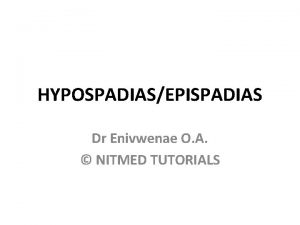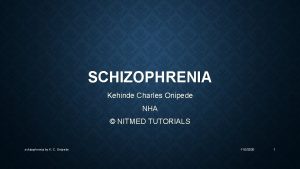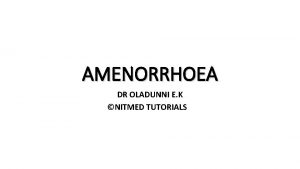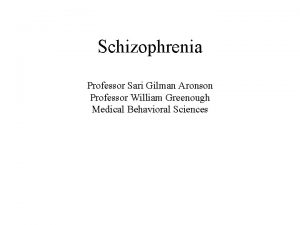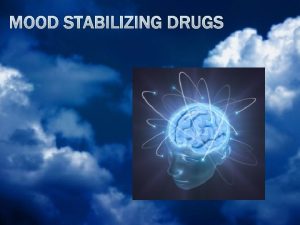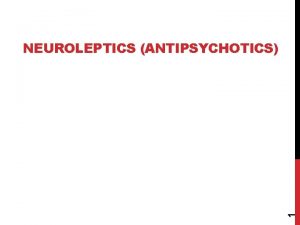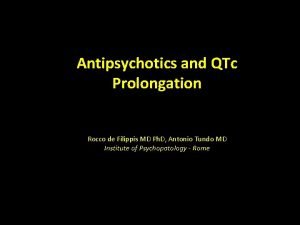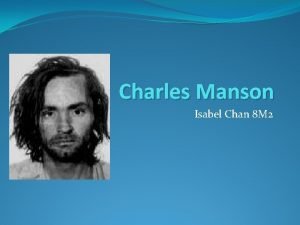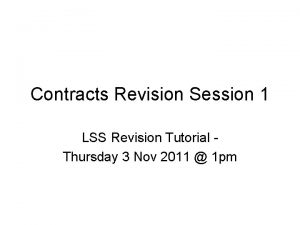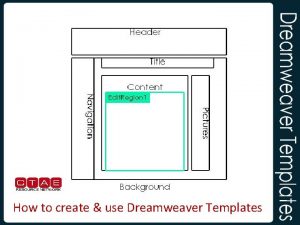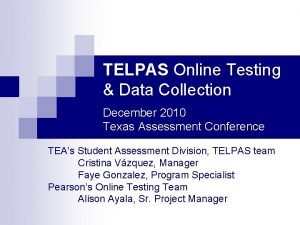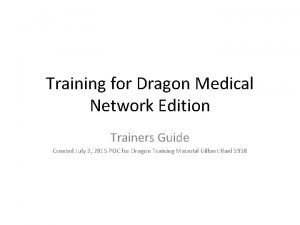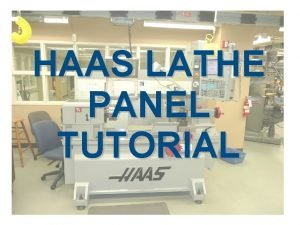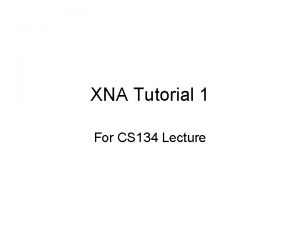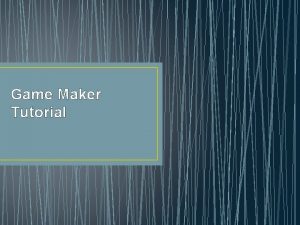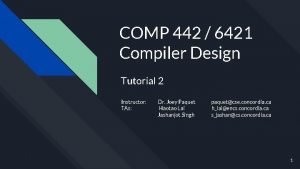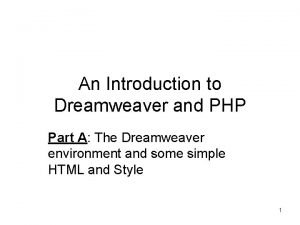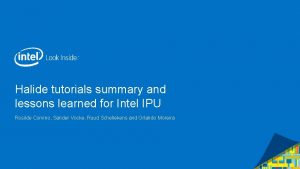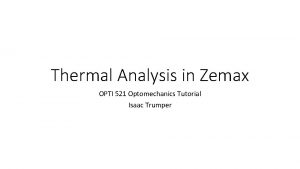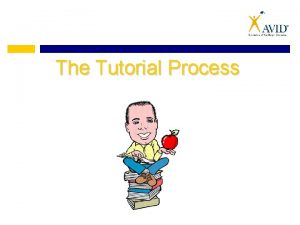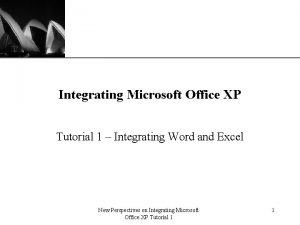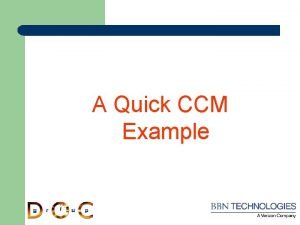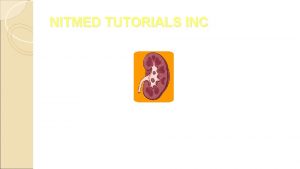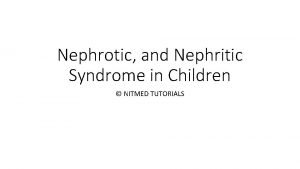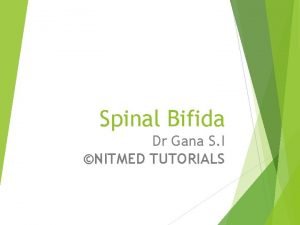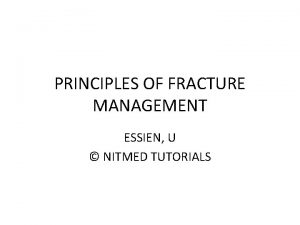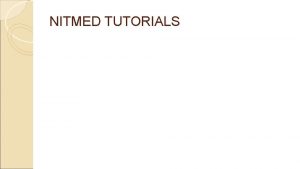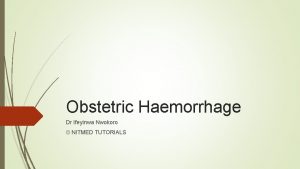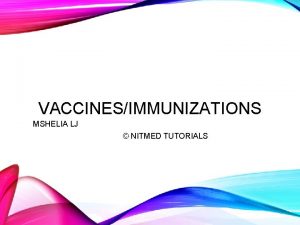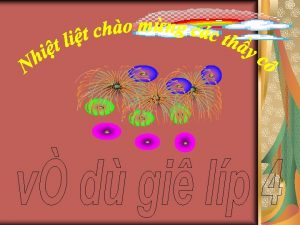ANTIPSYCHOTICS KEHINDE CHARLES ONIPEDE NHA NITMED TUTORIALS Antipsychotics



































- Slides: 35

ANTIPSYCHOTICS KEHINDE CHARLES ONIPEDE NHA © NITMED TUTORIALS Antipsychotics - K. C. Onipede 1

OUTLINE • INTRODUCTION • CLASSIFICATION • MECHANISM OF ACTION • SIDE EFFECTS • TREATMENT RESISTANT SCHIZOPHRENIA • CLOZAPINE • DEPOT INJECTIONS Antipsychotics - K. C. Onipede 2

ANTI-PSYCHOTICS • Mainstay of pharmacological treatment for schizophrenia and related disorders • Diminish positive symptoms such as hallucinations, delusions, thought disorder • Some impact on negative symptoms such as lack of motivation, blunted affect, cognitive impairment • Important as a part of relapse prevention Antipsychotics - K. C. Onipede 3

ANTI-PSYCHOTICS • Antagonise dopamine receptors, resulting in anti-psychotic effects • Indications-schizophrenia, acute mania, psychotic depression, • Conventional and atypical • Both of equivalent efficacy when taken at recommended dosages • Atypicals have lower incidence of EPSE Antipsychotics - K. C. Onipede 4

DOPAMINE THEORY • The dopamine hypothesis of psychosis – overactivity of dopamine neurons in the mesolimbic pathway of the brain may mediate the positive symptoms of psychosis • Mesolimbic pathway responsible for pleasure, effects of drugs and alcohol and hallucinations and delusions Antipsychotics - K. C. Onipede 5

Antipsychotics - K. C. Onipede 6

BLOCKADE OF D 2 RECEPTORS? D 2 ANTAGONIST Nigrostriatal pathway extrapyramidal side effects (EPS) and tardive dyskinesia Mesocortical pathway enhanced negative and cognitive psychotic symptoms Mesolimbic pathway dramatic therapeutic action on positive psychotic symptoms Antipsychotics - K. C. Onipede Tuberoinfundibular pathway hyperprolactinemia (lactation, 7

DOPAMINE RECEPTORS • Five subtypes – D 2 most important in terms of psychosis • Blockade of mesolimbic receptors leads to reduced psychotic symptoms • Blockade of the mesocortical pathway leads to increased negative symptoms Antipsychotics - K. C. Onipede 8

DOPAMINE RECEPTORS • Dopamine and acetylcholine have a reciprocal relationship • • Blockade of dopamine receptors increases the activity of acetylcholine Over activity of acetylcholine causes EPSE Blockade of dopamine causes movement disorders in the nigostriatal pathway Long tem blockade causes “upregulation” and leads to Tardive Dyskinesia Antipsychotics - K. C. Onipede 9

CONVENTIONAL OR TYPICAL ANTIPSYCHOTICS • Have four actions – blockade of: • Dopamine 2 • Muscarinic/cholinergic • Alpha adrenergic • Histamine Antipsychotics - K. C. Onipede 10

THE DOPAMINE RECEPTOR ANTAGONIST HYPOTHESIS OF ANTIPSYCHOTIC DRUG ACTION • Blockade of post synaptic dopamine receptors in the mesolimbic pathway is thought to mediate the efficacy of the drug and its ability to diminish positive symptoms Antipsychotics - K. C. Onipede 11

RECEPTOR AFFINITY Low Affinity (loosely bound) - Quetiapine, Olanzapine, Amisulpride, Clozapine High Affinity (tightly bound) - Haloperidol, Flupenthixol, Fluphenazine Tightly bound drugs lead to increased sensitivity to dopamine blockade so more likely to cause EPSE Antipsychotics - K. C. Onipede 12

ATYPICAL ANTIPSYCHOTICS • Pharmacologic Properties • 5 HT 2 A and D 2 antagonism (as opposed to conventional drugs which are D 2 without 5 HT 2 A antagonism) • Atypicals – blockade of D 2 and 5 HT 2 A Antipsychotics - K. C. Onipede 13

DOPAMINE AND SEROTONIN RECEPTORS • Dopamine and serotonin have a reciprocal relationship • Serotonin opposes the release of dopamine in the nigrostriatal and tuberofundibular pathways Antipsychotics - K. C. Onipede 14

DOPAMINE AND SEROTONIN RECEPTORS • Action of atypicals – firstly binds to the D 2 receptor • Secondly, binds to the 5 HT 2 A receptor • The second action reverses the first – reverses the blockade of D 2 • Blocking 5 HT 2 A disinhibits the dopamine neuron causing dopamine to pour out Antipsychotics - K. C. Onipede 15

DOPAMINE AND SEROTONIN RECEPTORS • The dopamine and serotonin then compete with the drug for the D 2 receptor • Increased dopamine in the mesocortical pathway • Reduction in movement disorders/EPSE for atypical antipsychotics Antipsychotics - K. C. Onipede 16

ATYPICALS VERSUS CONVENTIONAL • All equal efficacy (except Clozapine) • Consideration for: • Merits of high versus low affinity drugs • Cerebral selectivity of the drugs • Adverse effect profile • Dose necessary to achieve optimal D 2 blockade • Patient tolerability, preference, response Antipsychotics - K. C. Onipede 17

ANTI-PSYCHOTICS • Conventional – e. g. chlorpromazine, haloperidol, stelazine, depots such as flupenthixol, zuclopenthixol, fluphenazine • Atypical – e. g. olanzapine, risperidone, quetiapine, amisulpride, clozapine, risperdal consta intramuscular injection, aripiprazole, paliperidone, ziprasidone • Also have effects on acetylcholine, histamine, serotonin receptors – varying adverse effects Antipsychotics - K. C. Onipede 18

ATYPICAL ANTIPSYCHOTICS • The ‘newer” antipsychotics • Effectively treat psychotic symptoms • Lower incidence of extra pyramidal side effects than conventional agents • Have effects on dopamine, serotonin, histamine and muscarinic receptors Antipsychotics - K. C. Onipede 19

ATYPICAL ANTIPSYCHOTICS • Current atypicals in use: • Amisulpride • Aripiprazole • Quetiapine • Olanzapine • Risperidone • Clozapine • Ziprasidone • Paliperidone Antipsychotics - K. C. Onipede 20

THERAPEUTIC EFFECTS ON SYMPTOMS • Agitation, sleep and appetite often respond in the first 1 -2 weeks • Personal hygiene and basic interpersonal socialisation may take 2 -3 weeks and psychotic symptoms can gradually decrease over 2 -6 weeks • An effective trial should be at least 6 -8 weeks at doses that are within the prescribed range Antipsychotics - K. C. Onipede 21

HOW LONG SHOULD ANTIPSYCHOTICS BE TAKEN FOR? • At least 6 months after an acute episode reduces relapse rates • If the person experiences another episode they may need antipsychotic medication for 2 -5 years before ceasing use • For those with multiple episodes, they may need medication for much of their life Antipsychotics - K. C. Onipede 22

ADVERSE EFFECTS • Sedation • Postural hypotension • Anticholinergic effects – dry mouth, blurred vision, constipation, urinary hesitancy • Weight gain-clozapine, olanzapine • Metabolic effects-increased serum lipids, impaired glucose tolerance-clozapine, olanzapine, quetiapine Antipsychotics - K. C. Onipede 23

ADVERSE EFFECTS • Hyperprolactinaemia-leads to galactorrhoea, amenorrhoea, decreased libido • Sexual dysfunction • QTc prolongation-leads to cardiac arrhythmias • EPSE-extrapyramidal side effects • Acute dystonias -laryngeal spasm, oculogyric crises • Akathisia-severe sense of agitation, inner restlessness in the limbs, especially the legs Antipsychotics - K. C. Onipede 24

ADVERSE EFFECTS • Akathesia – a severe sense of psychomotor agitation • Parkinsonism -poverty of movement, tremor, rigidity, drooling, hypersalivation • Tardive dyskinesia-involuntary hyperkinetic movements, affects the mouth, lips, tongue, jaws with smacking, tongue writhing, sucking, chewing and tic like movements, limbs and trunk can be affected Antipsychotics - K. C. Onipede 25

ADVERSE EFFECTS • Irreversible in some patients • Neuroleptic malignant syndrome-rare but potentially fatal – high temp, muscle rigidity, altered consciousness, raised creatinine kinase –cease medication • Can happen at anytime during treatment • 30% patients will develop syndrome again on rechallenge Antipsychotics - K. C. Onipede 26

DEPOT ANTI-PSYCHOTICS • Used when concerns around compliance • Conventional-zuclopenthixol(useful for agitated, aggressive, disturbed behaviour) flupenthixol (may have mood elevating effects) fluphenazine -EPSE common • Typical-Risperdal Consta – onset of action 3 weeks, need oral Risperidone to supplement until peak plasma reached Antipsychotics - K. C. Onipede 27

DRUG INTERACTIONS • Cytochrome P 450 isoenzymes are significant in psychotropic drug interactions • Inducers or inhibitors of this pathway may produce clinically important drug interactions • May lead to increase or decrease of medications due to interactions Antipsychotics - K. C. Onipede 28

CYTOCHROME P 450 • Examples • • • Fluvoxamine inhibits olanzapine and clozapine metabolism Smoking induces Olanzapine metabolism SSRIs inhibit most antipsychotics and therefore increase serum concentrations Phenytoin reduces serum concentration of Quetiapine Others – grapefruit juice, Antibiotics, Antipsychotics - K. C. Onipede 29

CLOZAPINE • Used when previously unresponsive to other antipsychotics • Serious adverse effect profile • Strict guidelines relating to commencement and monitoring • Significant risk of agranulocytosis • Trial at least 2 different standard antipsychotics at an adequate dose and for an adequate duration prior to commencing Clozapine Antipsychotics - K. C. Onipede 30

USE OF ANTIPSYCHOTICS WITH OLDER PERSONS • Various disorders treated with antipsychotics in the elderly – psychosis, bipolar affective disorder, delirium & dementia • Use extreme caution because of side effect profile • ‘Start low & go slow’ (Malone et al 2007) & titrate over longer periods of time to reach the required dose • Avoid polypharmacy wherever possible Antipsychotics - K. C. Onipede 31

PREGNANCY & LACTATION • Avoid antipsychotics if possible • Use the lowest effective dose • Neonatal adverse effects observed include generalised hypertonicity and dystonic reactions Antipsychotics - K. C. Onipede 32

PREGNANCY & LACTATION • The safety of atypical agents is yet to be established but preliminary reports there to be no deleterious effects to the foetus • Isolated cases of congenital abnormalities with the use of Clozapine Antipsychotics - K. C. Onipede 33

PREGNANCY & LACTATION • No increased risk has emerged with the use of Olanzapine • The conventional agents are generally preferred • Supervised dose reduction and cessation 7 -10 days prior to delivery should be considered Antipsychotics - K. C. Onipede 34

CONCLUSION • Conventional and atypical antipsychotics are used as the foundation for pharmacological management of schizophrenia and related psychosis • All have equal efficacy, exception Clozapine • Atypicals generally better tolerated & have less EPSE • Atypicals first line treatment • Start lowest effective possible dose & titrate upwards • Ongoing monitoring & management of adverse effects • Caution numerous drug interaction & potential for neuroleptic malignant syndrome Antipsychotics - K. C. Onipede 35
 Nitmed tutorials
Nitmed tutorials Nitmed tutorials
Nitmed tutorials Nitmed
Nitmed Nitmed tutorials
Nitmed tutorials Nitmed
Nitmed Wide carrying angle
Wide carrying angle Inventor of partograph
Inventor of partograph Nitmed tutorials
Nitmed tutorials Kehinde wiley bio
Kehinde wiley bio Afrodizzia medicine
Afrodizzia medicine Antipsychotics brain damage
Antipsychotics brain damage Lithium mood stabilizer mechanism action
Lithium mood stabilizer mechanism action First generation antipsychotics vs second
First generation antipsychotics vs second Mesolimbic
Mesolimbic Qtc prolongation female
Qtc prolongation female Charles manson childhood
Charles manson childhood Lss software tutorials
Lss software tutorials Dreamweaver templates tutorials
Dreamweaver templates tutorials Telpas online test student tutorials
Telpas online test student tutorials Dragon medical tutorials
Dragon medical tutorials Haas door override setting
Haas door override setting Xna framework tutorial
Xna framework tutorial Game maker
Game maker Comp 442
Comp 442 Dreamweaver php extensions
Dreamweaver php extensions Halide tutorial
Halide tutorial Asp net tutorialspoint
Asp net tutorialspoint Zemax thermal analysis
Zemax thermal analysis Avid tutorial process
Avid tutorial process Microsoft office xp tutorials
Microsoft office xp tutorials Adp etime portal
Adp etime portal Radiologymasterclass.co.uk › tutorials
Radiologymasterclass.co.uk › tutorials Ccm examples
Ccm examples Zemax tutorials
Zemax tutorials Roofit tutorials
Roofit tutorials Online planbook
Online planbook


